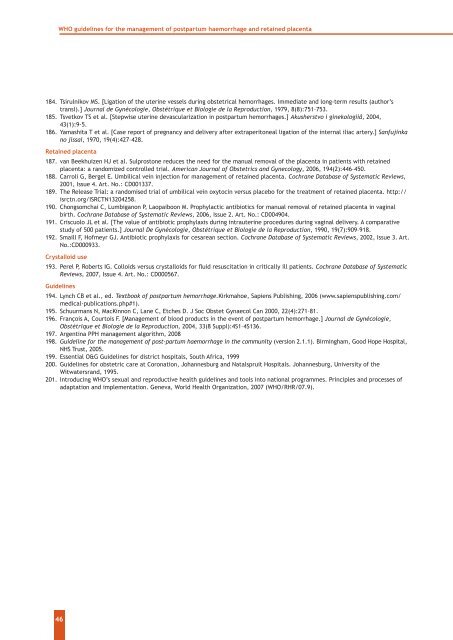WHO guidelines for the management of postpartum haemorrhage ...
WHO guidelines for the management of postpartum haemorrhage ...
WHO guidelines for the management of postpartum haemorrhage ...
Create successful ePaper yourself
Turn your PDF publications into a flip-book with our unique Google optimized e-Paper software.
<strong>WHO</strong> <strong>guidelines</strong> <strong>for</strong> <strong>the</strong> <strong>management</strong> <strong>of</strong> <strong>postpartum</strong> <strong>haemorrhage</strong> and retained placenta<br />
184. Tsirulnikov MS. [Ligation <strong>of</strong> <strong>the</strong> uterine vessels during obstetrical hemorrhages. Immediate and long-term results (author’s<br />
transl).] Journal de Gynécologie, Obstétrique et Biologie de la Reproduction, 1979, 8(8):751–753.<br />
185. Tsvetkov TS et al. [Stepwise uterine devascularization in <strong>postpartum</strong> hemorrhages.] Akusherstvo i ginekologiiâ, 2004,<br />
43(1):9‐5.<br />
186. Yamashita T et al. [Case report <strong>of</strong> pregnancy and delivery after extraperitoneal ligation <strong>of</strong> <strong>the</strong> internal iliac artery.] Sanfujinka<br />
no jissai, 1970, 19(4):427–428.<br />
Retained placenta<br />
187. van Beekhuizen HJ et al. Sulprostone reduces <strong>the</strong> need <strong>for</strong> <strong>the</strong> manual removal <strong>of</strong> <strong>the</strong> placenta in patients with retained<br />
placenta: a randomized controlled trial. American Journal <strong>of</strong> Obstetrics and Gynecology, 2006, 194(2):446–450.<br />
188. Carroli G, Bergel E. Umbilical vein injection <strong>for</strong> <strong>management</strong> <strong>of</strong> retained placenta. Cochrane Database <strong>of</strong> Systematic Reviews,<br />
2001, Issue 4. Art. No.: CD001337.<br />
189. The Release Trial: a randomised trial <strong>of</strong> umbilical vein oxytocin versus placebo <strong>for</strong> <strong>the</strong> treatment <strong>of</strong> retained placenta. http://<br />
isrctn.org/ISRCTN13204258.<br />
190. Chongsomchai C, Lumbiganon P, Laopaiboon M. Prophylactic antibiotics <strong>for</strong> manual removal <strong>of</strong> retained placenta in vaginal<br />
birth. Cochrane Database <strong>of</strong> Systematic Reviews, 2006, Issue 2. Art. No.: CD004904.<br />
191. Criscuolo JL et al. [The value <strong>of</strong> antibiotic prophylaxis during intrauterine procedures during vaginal delivery. A comparative<br />
study <strong>of</strong> 500 patients.] Journal De Gynécologie, Obstétrique et Biologie de la Reproduction, 1990, 19(7):909–918.<br />
192. Smaill F, H<strong>of</strong>meyr GJ. Antibiotic prophylaxis <strong>for</strong> cesarean section. Cochrane Database <strong>of</strong> Systematic Reviews, 2002, Issue 3. Art.<br />
No.:CD000933.<br />
Crystalloid use<br />
193. Perel P, Roberts IG. Colloids versus crystalloids <strong>for</strong> fluid resuscitation in critically ill patients. Cochrane Database <strong>of</strong> Systematic<br />
Reviews, 2007, Issue 4. Art. No.: CD000567.<br />
Guidelines<br />
194. Lynch CB et al., ed. Textbook <strong>of</strong> <strong>postpartum</strong> hemorrhage.Kirkmahoe, Sapiens Publishing, 2006 (www.sapienspublishing.com/<br />
medical-publications.php#1).<br />
195. Schuurmans N, MacKinnon C, Lane C, Etches D. J Soc Obstet Gynaecol Can 2000, 22(4):271–81.<br />
196. François A, Courtois F. [Management <strong>of</strong> blood products in <strong>the</strong> event <strong>of</strong> <strong>postpartum</strong> hemorrhage.] Journal de Gynécologie,<br />
Obstétrique et Biologie de la Reproduction, 2004, 33(8 Suppl):4S1–4S136.<br />
197. Argentina PPH <strong>management</strong> algorithm, 2008<br />
198. Guideline <strong>for</strong> <strong>the</strong> <strong>management</strong> <strong>of</strong> post-partum <strong>haemorrhage</strong> in <strong>the</strong> community (version 2.1.1). Birmingham, Good Hope Hospital,<br />
NHS Trust, 2005.<br />
199. Essential O&G Guidelines <strong>for</strong> district hospitals, South Africa, 1999<br />
200. Guidelines <strong>for</strong> obstetric care at Coronation, Johannesburg and Natalspruit Hospitals. Johannesburg, University <strong>of</strong> <strong>the</strong><br />
Witwatersrand, 1995.<br />
201. Introducing <strong>WHO</strong>’s sexual and reproductive health <strong>guidelines</strong> and tools into national programmes. Principles and processes <strong>of</strong><br />
adaptation and implementation. Geneva, World Health Organization, 2007 (<strong>WHO</strong>/RHR/07.9).<br />
46
















